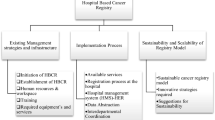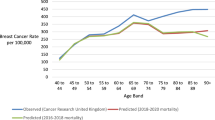Abstract
Purpose
Effects of geographic program expansion to rural areas on screening program outcomes are understudied. We sought to determine whether time-to-resolution (TTR) varied significantly by service delivery time period, location, and participant characteristics across 19 North Texas counties.
Methods
We calculated proportions undergoing diagnostic follow-up and resolved ≤ 60 days. We calculated median TTR for each time period and abnormal result BI-RADS 0, 4, 5. Cox proportional hazards regressions estimated time period and patient characteristic effects on TTR. Wilcoxon rank sum tests evaluated whether TTR differed between women who did or did not transfer between counties for services.
Results
TTR ranged from 14 to 17 days for BI-RADs 0, 4, and 5; 12.4% transferred to a different county, resulting in longer median TTR (26 vs. 16 days; p < .001). Of those completing follow-up, 92% were resolved ≤ 60 days (median 15 days). For BI-RAD 3, TTR was 208 days (including required 180 day waiting period). Follow-up was significantly lower for women with BI-RAD 3 (59% vs. 96%; p < .0001).
Conclusion
Expansion maintained timely service delivery, increasing access to screening among rural, uninsured women. Policies adding a separate quality metric for BI-RAD 3 could encourage follow-up monitoring to address lower completion and longer TTR among women with this result.



Similar content being viewed by others
Abbreviations
- BCCS:
-
Breast and cervical cancer services (Texas’ NBCCEDP-funded program)
- BSPAN:
-
Breast screening and patient navigation program
- BI-RAD:
-
Breast imaging-reporting and data system
- NBCCEDP:
-
National breast and cervical cancer early detection program
- TTR:
-
Time to resolution
References
Elmore JG (2016) Review: mammography screening reduces breast cancer mortality in women at average risk. Ann Intern Med 164:Jc26
Beaber EF, Kim JJ, Schapira MM et al (2015) Unifying screening processes within the PROSPR consortium: a conceptual model for breast, cervical, and colorectal cancer screening. J Natl Cancer Inst 107:djv120
Taplin SH, Yabroff KR, Zapka J (2012) A multilevel research perspective on cancer care delivery: the example of follow-up to an abnormal mammogram. Cancer Epidemiol Biomarkers Prev 21:1709–1715
Oeffinger KC, Fontham EH, Etzioni R et al (2015) Breast cancer screening for women at average risk: 2015 guideline update from the american cancer society. JAMA 314:1599–1614
Goldman LE, Walker R, Hubbard R, Kerlikowske K, Consortium BCS (2013) Timeliness of abnormal screening and diagnostic mammography follow-up at facilities serving vulnerable women. Med Care 51:307
Leung J, McKenzie S, Martin J, McLaughlin D (2014) Effect of rurality on screening for breast cancer: a systematic review and meta-analysis comparing mammography. Rural Remote Health 14:2730
US Census Bureau (2010) 2010 census urban and rural classification and urban area criteria, percent urban and rural in 2010 by state and county. US Census Bureau, Washington DC
Allen JD, Shelton RC, Harden E, Goldman RE (2008) Follow-up of abnormal screening mammograms among low-income ethnically diverse women: findings from a qualitative study. Patient Educ Couns 72:283–292
Katz ML, Young GS, Reiter PL et al (2013) Barriers reported among patients with breast and cervical abnormalities in the patient navigation research program: impact on timely care. Womens Health Issues 24:e155–e162
Raich PC, Whitley EM, Thorland W, Valverde P, Fairclough D (2012) Patient navigation improves cancer diagnostic resolution: an individually randomized clinical trial in an underserved population. Cancer Epidemiol Biomarkers Prev 21:1629–1638
Dudley DJ, Drake J, Quinlan J et al (2012) Beneficial effects of a combined navigator/promotora approach for hispanic women diagnosed with breast abnormalities. Cancer Epidemiol Biomarkers Prev 21:1639–1644
Markossian TW, Darnell JS, Calhoun EA (2012) Follow-up and timeliness after an abnormal cancer screening among underserved, urban women in a patient navigation program. Cancer Epidemiol Biomarkers Prev 21:1691–1700
Hoffman HJ, LaVerda NL, Young HA et al (2012) Patient navigation significantly reduces delays in breast cancer diagnosis in the district of Columbia. Cancer Epidemiol Biomarkers Prev 21:1655–1663
Paskett ED, Katz ML, Post DM et al (2012) The Ohio patient navigation research program: does the American Cancer Society patient navigation model improve time to resolution in patients with abnormal screening tests? Cancer Epidemiol Biomarkers Prev 21:1620–1628
Wells KJ, Lee JH, Calcano ER et al (2012) A cluster randomized trial evaluating the efficacy of patient navigation in improving quality of diagnostic care for patients with breast or colorectal cancer abnormalities. Cancer Epidemiol Biomarkers Prev 21:1664–1672
Tiro JA, Inrig SJ, Balasubramanian BA, Sanders JM, McCallister K, Halm EA, Bishop WP, Murphy CC, Santino NO, Lee SJC (2018) Clinic variation in colorectal cancer screening in an integrated system. Popul Health Manage (in press)
Lee SJC, Inrig SJ, Balasubramanian BA et al (2018) Identifying quality improvement targets to facilitate colorectal cancer screening completion. Prev Med Rep 9:138–143
Krok-Schoen JL, Kurta ML, Weier RC et al (2015) Clinic type and patient characteristics affecting time to resolution after an abnormal cancer-screening exam. Cancer Epidemiol Biomarkers Prev 24:162–168
Milat AJ, Bauman A, Redman S (2015) Narrative review of models and success factors for scaling up public health interventions. Implement Sci 10:113
Yancy B, Royalty JE, Marroulis S, Mattingly C, Benard VB, DeGroff A (2014) Using data to effectively manage a national screening program. Cancer 120:2575–2583
Siegl EJ, Miller JW, Khan K, Harris SE (2014) Quality assurance through quality improvement and professional development in the national breast and cervical cancer early detection program. Cancer 120:2584–2590
Martinez-Donate A, Halverson J, Simon NJ, Strickland S et al (2013) Identifying health literacy and health system navigation needs among rural cancer patients: findings from the rural oncology literacy enhancement study (ROLES). J Canc Educ 28:573–581
Richardson LC, Royalty J, Howe W, Helsel W, Kammerer W, Benard VB (2010) Timeliness of breast cancer diagnosis and initiation of treatment in the national breast and cervical cancer early detection program, 1996–2005. Am J Public Health 100:1769–1776
Benard VB, Howe W, Royalty J, Helsel W, Kammerer W, Richardson LC (2012) Timeliness of cervical cancer diagnosis and initiation of treatment in the national breast and cervical cancer early detection program. J Womens Health 21:776–782
Inrig SJ, Higashi RT, Tiro JA, Argenbright KE, Lee SJC (2017) Assessing local capacity to expand rural breast cancer screening and patient navigation: an iterative mixed-method tool. Eval Program Plann 61:113–124
Lee SJC, Higashi RT, Inrig SJ et al (2017) County-level outcomes of a rural breast cancer screening outreach strategy: a decentralized hub-and-spoke model (BSPAN2). Transl Behav Med 7:349–357
Argenbright K, Anderson RP, Senter M, Lee SJC (2013) Breast screening and patient navigation in rural Texas counties: strategic steps. Texas Public Health J 65:25–27
Robinson JC, Casalino LP (1996) Vertical integration and organizational networks in health care. Health Aff 15:7–22
Inrig SJ, Tiro JA, Melhado TV, Argenbright KE, Craddock Lee SJ (2014) Evaluating a de-centralized regional delivery system for breast cancer screening and patient navigation for the rural underserved. Texas Public Health J 66:25–34
American Cancer Society (2016) What is a BI-RADS score?
Battaglia TA, Bak SM, Heeren T et al (2012) Boston patient navigation research program: the impact of navigation on time to diagnostic resolution after abnormal cancer screening. Cancer Epidemiol Biomarkers Prev 21:1645–1654
Tosteson AN, Beaber EF, Tiro J et al (2016) Variation in screening abnormality rates and follow-up of breast, cervical and colorectal cancer screening within the PROSPR consortium. J Gen Intern Med 31:372–379
Lee JH, Fulp W, Wells KJ, Meade CD, Calcano E, Roetzheim R (2013) Patient navigation and time to diagnostic resolution: results for a cluster randomized trial evaluating the efficacy of patient navigation among patients with breast cancer screening abnormalities, Tampa, FL. PLoS ONE 8:e74542
Caplan LS, Helzlsouer KJ, Shapiro S, Wesley MN, Edwards BK (1996) Reasons for delay in breast cancer diagnosis. Prev Med 25:218–224
Katz ML, Kauffman RM, Tatum CM, Paskett ED (2008) Influence of church attendance and spirituality in a randomized controlled trial to increase mammography use among a low-income, tri-racial, rural community. J Relig Health 47:227–236
Gaudet A, Kelley ML, Williams A (2014) Understanding the distinct experience of rural interprofesional collaboration in developing palliative care programs. Rural and Remote Health
Whitten P, Holtz B, Nguyen L (2010) Keys to a successful and sustainable telemedicine program. Int J Technol Assess Health Care 26(2):211–216
George M, Ngo P, Prawira A (2014) Rural oncology: overcoming the tyranny of distance for improved cancer care. J Oncol Pract 10:e146–e149
Texas State Department of Health Services (DSHS) (2011) Policy and procedure manual for breast and cervical cancer services, fiscal year 2012. Austin, TX
Elkin EB, Ishill NM, Snow JG (2010) Geographic access and the use of screening mammography. Med Care 48:349
Post DM, McAlearney AS, Young GS, Krok-Schoen JL, Plascak JJ, Paskett ED (2015) Effects of patient navigation on patient satisfaction outcomes. J Cancer Educ 30:728–735
Schutt RK, Cruz ER, Woodford ML (2008) Client satisfaction in a breast and cervical cancer early detection program: the influence of ethnicity and language, health, resources, and barriers. Women Health 48:283–302
Goldstein LJ, Miller BJ, Nicotera N, Pendleton D (2014) Reducing the time from initial call to first appointment: the impact of patient access redesign and a nurse navigation program. J Natl Compr Cancer Netw 12(Suppl 1):S16–S18
Brett J, Bankhead C, Henderson B, Watson E, Austoker J (2005) The psychological impact of mammographic screening. A systematic review. Psycho-oncology 14:917–938
Azami-Aghdash S, Ghojazadeh M, Sheyklo SG et al (2015) Breast cancer screening barriers from the womans perspective: a meta-synthesis. Asian Pac J Cancer Prev 16:3463–3471
Edwards SA, Chiarelli AM, Ritvo P, Stewart L, Majpruz V, Mai V (2011) Satisfaction with initial screen and compliance with biennial breast screening at centers with and without nurses. Cancer Nurs 34:293–301
Peipins LA, Shapiro JA, Bobo JK, Berkowitz Z (2006) Impact of women’s experiences during mammography on adherence to rescreening (United States). Cancer Causes Control 17:439–447
Cole MB, Wright B, Wilson IB, Galárraga O, Trivedi AN (2018) Medicaid expansion and community health centers: care quality and service use increased for rural patients. Health Aff 37:900–907
Sickles E, D’Orsi CJ (2013) ACR BI-RADS® follow-up and outcome monitoring. ACR BI-RADS® atlas, breast imaging reporting and data system. American College of Radiology, Reston
Acknowledgments
This study was funded by the Cancer Prevention Research Institute of Texas (PP120097; PP150053; Lee), which has underwritten the BSPAN clinical screening and navigation program since 2009. Additional support was provided by the National Cancer Institute (5P30CA142543) to the Harold C. Simmons Comprehensive Cancer Center and National Institutes of Health (NCATS UL1TR001105) to the UT Southwestern Center for Translational Medicine. Drs. Lee and Tiro are also supported by funding from the Agency for Healthcare Research and Quality (R24 HS022418) to the UT Southwestern Center for Patient-Centered Outcomes Research. The authors thank Melanie Carithers and Early Detection Program colleagues at Moncrief Cancer Institute for their ongoing collaboration and dedication to patients, and the many county partner organizations.
Author information
Authors and Affiliations
Corresponding author
Ethics declarations
Conflict of interest
All authors declare no conflicts of interest.
Ethical approval
All procedures performed in studies involving human participants were in accordance with the ethical standards of the institutional and/or national research committee and with the 1964 Helsinki declaration and its later amendments or comparable ethical standards. The study was approved by UT Southwestern Institutional Review Board (STU 022012-009; PI: Lee).
Appendix
Appendix
See Table 3.
Rights and permissions
About this article
Cite this article
Lee, S.C., Higashi, R.T., Sanders, J.M. et al. Effects of program scale-up on time to resolution for patients with abnormal screening mammography results. Cancer Causes Control 29, 995–1005 (2018). https://doi.org/10.1007/s10552-018-1074-4
Received:
Accepted:
Published:
Issue Date:
DOI: https://doi.org/10.1007/s10552-018-1074-4




